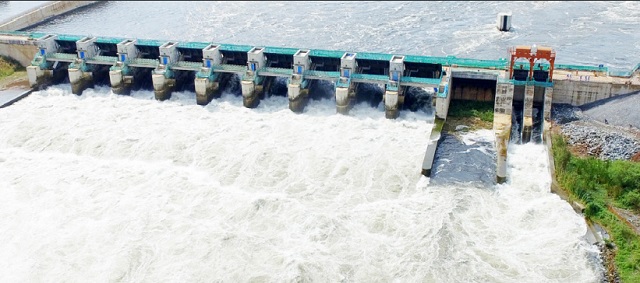
While hydro dams emits no greenhouse gases, reservoirs can be worse than fossil-fuel power plants
COMMENT | BRAHMA CHELLANEY | The era of cheap oil and gas is over. Russia’s war in Ukraine – or, more specifically, Europe’s ambitious effort to wean itself off Russian fossil fuels at a time when international supplies are already tight – is driving up global energy prices and raising the specter of a global energy crisis. Alternative sources of energy are looking more appealing by the day, as they should. But the embrace of hydropower, in particular, carries its own risks.
Hydropower is currently the most widely used renewable, accounting for almost half of all low-carbon electricity generation worldwide. Its appeal is rooted in several factors. For decades, it was the most cost-competitive renewable, and many hydropower plants can increase or decrease their electricity generation much faster than nuclear, coal, and natural-gas plants. And whereas wind and solar output can fluctuate significantly, hydropower can be dependably produced using reservoirs, making it a good complement to these more variable sources.
But there is a hitch. The most common type of hydropower plant entails the damming of rivers and streams. And hydroelectric dams have a large and lasting ecological footprint.
For starters, while hydroelectric generation itself emits no greenhouse gases, dams and reservoirs emit significant amounts of methane, carbon dioxide, and nitrous oxide. Under some circumstances – such as in tropical zones – they can generate more greenhouse gases than fossil-fuel power plants. One study found that methane – a greenhouse gas that is at least 34 times more potent than CO2 – can make up some 80% of emissions from artificial reservoirs, though a wide variety of geographical, climatic, seasonal, and vegetational factors affect reservoir emissions.
Moreover, while hydroelectric dams are often touted for delivering clean drinking water, controlling floods, and supporting irrigation, they also change river temperatures and water quality and impede the flow of nutrient-rich sediment. Such sediment is essential to help re-fertilise degraded soils in downstream plains, prevent the erosion of the river channel, and preserve biodiversity.
When dams trap the sediment flowing in from the mountains, deltas shrink and sink. This allows salt water to intrude inland, thereby disturbing the delicate balance between fresh water and salt water that is essential for the survival of critical species in coastal estuaries and lagoons. It also exposes deltas to the full force of storms and hurricanes. In Asia, heavily populated deltas – home to megacities like Tianjin, Shanghai, Guangzhou, Bangkok, and Dhaka – are already retreating fast.
Dams also carry high social costs. In 2007, then-Chinese Prime Minister Wen Jiabao revealed that China had relocated 22.9 million people to make way for water projects – a figure larger than the populations of more than 100 countries. The Three Gorges Dam, the world’s largest hydropower station, which became fully operational in 2012, displaced more than 1.4 million people.
To top it all off, there is good reason to doubt hydropower’s reliability. If mitigation measures prove unable to slow global warming adequately – an increasingly likely scenario – the frequency and intensity of droughts will continue to rise. As water levels in rivers and reservoirs drop – exacerbated by evaporation from open reservoirs – so will the water pressure needed to spin turbines, resulting in less electricity. And this is to say nothing of giant dams’ ability to compound downstream droughts, as has been seen in the Mekong River Basin.
Given that dams are expensive, years-long undertakings, the wisdom of investing in building more of them is questionable, to say the least. But the world’s love affair with dams continues. Almost two-thirds of the Earth’s long rivers have already been modified by humans, with most of the world’s almost 60,000 large dams having been built over the last seven decades. And, global dam construction continues at a breakneck pace. In 2014, at least 3,700 significant dams were under construction or planned. Since then, the dam boom has become more apparent, with the developing world now a global hotspot of such construction.
While dam-building activity can be seen from the Balkans to South America, China leads the way as both the world’s most-dammed country and its largest exporter of dams. From 2001 to 2020, China lent over $44 billion for the Chinese construction of hydropower projects totaling over 27 gigawatts in 38 countries.
China is not hesitating to build dams even in seismically active areas, despite the risk of triggering a devastating earthquake. And China really should know better: its own scientists linked the 2008 Wenchuan earthquake, which killed more than 87,000 people in the Tibetan Plateau’s eastern rim, to the new Zipingpu Dam, located near the quake’s epicenter.
There is no question that the world must cut its reliance on fossil fuels. But building more hydroelectric dams – especially in the Earth’s most biodiverse river basins, such as the Amazon, the Brahmaputra, the Congo, and the Mekong – is not the way to do it. On the contrary, the global dam frenzy amounts to a kind of a Faustian bargain, in which we trade our planet’s long-term health for a fleeting sense of energy security.
****
Brahma Chellaney, Professor of Strategic Studies at the New Delhi-based Center for Policy Research and Fellow at the Robert Bosch Academy in Berlin, is the author of `Water, Peace, and War: Confronting the Global Water Crisis’ (Rowman & Littlefield, 2013).
Copyright: Project Syndicate, 2022.
 The Independent Uganda: You get the Truth we Pay the Price
The Independent Uganda: You get the Truth we Pay the Price



